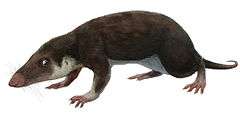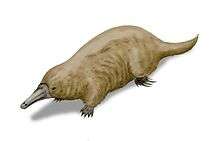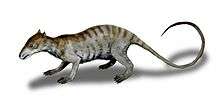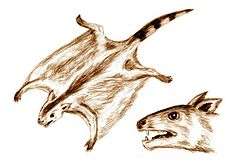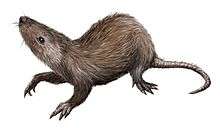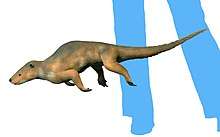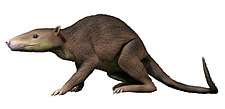Eutheria
Eutheria (/juːˈθɪəriə/; from Greek εὐ-, eu- "good" or "right" and θηρίον, thēríon "beast" hence "true beasts") is one of two mammalian clades with extant members that diverged in the Early Cretaceous or perhaps the Late Jurassic. Except for the North American Virginia opossum, which is a metatherian (marsupial), all post-Miocene mammals indigenous to Europe, Africa, Asia, and North America north of Mexico are eutherians. Extant eutherians, their last common ancestor, and all extinct descendants of that ancestor are members of Placentalia.
| Eutheria | |
|---|---|
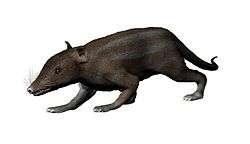 | |
| Juramaia, the oldest known eutherian | |
| Scientific classification | |
| Kingdom: | Animalia |
| Phylum: | Chordata |
| Class: | Mammalia |
| Subclass: | Theria |
| Clade: | Eutheria Gill, 1872 |
| Subgroups | |
| |
Eutherians are distinguished from noneutherians by various phenotypic traits of the feet, ankles, jaws and teeth. All extant eutherians lack epipubic bones, which are present in all other living mammals (marsupials and monotremes). This allows for expansion of the abdomen during pregnancy.[2]
The oldest-known eutherian species is Juramaia sinensis, dated at 161 million years ago from the Jurassic in China.[3]
Eutheria was named in 1872 by Theodore Gill; in 1880 Thomas Henry Huxley defined it to encompass a more broadly defined group than Placentalia.[4]
Characteristics
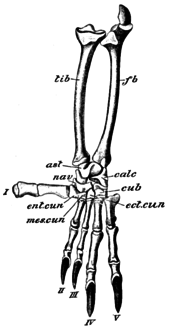
Distinguishing features are:
- an enlarged malleolus ("little hammer") at the bottom of the tibia, the larger of the two shin bones[5]
- the joint between the first metatarsal bone and the entocuneiform bone (the outermost of the three cuneiform bones) in the foot is offset farther back than the joint between the second metatarsal and middle cuneiform bones—in metatherians these joints are level with each other[5]
- various features of jaws and teeth[5]
Evolutionary history
Eutheria contains several extinct genera as well as larger groups, many with complicated taxonomic histories still not fully understood. Members of the Adapisoriculidae, Cimolesta and Leptictida have been previously placed within the out-dated placental group Insectivora, while Zhelestids have been considered primitive ungulates.[6] However, more recent studies have suggested these enigmatic taxa represent stem group eutherians, more basal to Placentalia.[7][8]
The weakly favoured cladogram favours Boreoeuthearia as a basal Eutherian clade as sister to the Atlantogenata.[9][10][11]
| Eutheria |
| ||||||||||||||||||
| The fossil eutherian species believed to be the oldest known is Juramaia sinensis, which lived about 160 million years ago.[3] Montanalestes was found in North America, while all other nonplacental eutherian fossils have been found in Asia. The earliest-known placental fossils have also been found in Asia.[5] | |||||||||||||||||||||||||||||||||||||||
† = extinct |
References
- Rook, Deborah L.; Hunter, John P. (April 2013). "Rooting Around the Eutherian Family Tree: the Origin and Relations of the Taeniodonta". Journal of Mammalian Evolution. 21: 75–91. doi:10.1007/s10914-013-9230-9.
- Reilly, Stephen M.; White, Thomas D. (2003-01-17). "Hypaxial Motor Patterns and the Function of Epipubic Bones in Primitive Mammals". Science. 299 (5605): 400–402. Bibcode:2003Sci...299..400R. doi:10.1126/science.1074905. ISSN 0036-8075. PMID 12532019.
- Luo, Z.; C. Yuan; Q. Meng; Q. Ji (2011). "A Jurassic eutherian mammal and divergence of marsupials and placentals". Nature. 476 (7361): 42–45. Bibcode:2011Natur.476..442L. doi:10.1038/nature10291. PMID 21866158.
- Eutheria (Placental Mammals) by J David Archibald, San Diego State University, San Diego, California, USA. PDF file from sdsu.edu
- Ji, Q.; Luo, Z-X.; Yuan, C-X.; Wible, J.R.; Zhang, J-P. & Georgi, J.A. (April 2002). "The earliest known eutherian mammal". Nature. 416 (6883): 816–822. Bibcode:2002Natur.416..816J. doi:10.1038/416816a. PMID 11976675.
- Rose, Kenneth D. (2006). The beginning of the age of mammals. Baltimore: Johns Hopkins University Press. ISBN 9780801892219.
- Wible, J. R.; Rougier, G. W.; Novacek, M. J.; Asher, R. J. (2007). "Cretaceous eutherians and Laurasian origin for placental mammals near the K/T boundary". Nature. 447 (7147): 1003–1006. Bibcode:2007Natur.447.1003W. doi:10.1038/nature05854. PMID 17581585.
- Wible, John R.; Rougier, Guillermo W.; Novacek, Michael J.; Asher, Robert J. (2009). "The Eutherian Mammal Maelestes gobiensis from the Late Cretaceous of Mongolia and the phylogeny of cretaceous eutheria" (PDF). Bulletin of the American Museum of Natural History. 327: 1–123. doi:10.1206/623.1. hdl:2246/6001.
- Foley, Nicole M.; Springer, Mark S.; Teeling, Emma C. (2016-07-19). "Mammal madness: is the mammal tree of life not yet resolved?". Phil. Trans. R. Soc. B. 371 (1699): 20150140. doi:10.1098/rstb.2015.0140. PMC 4920340. PMID 27325836.
- Tarver, James E.; Reis, Mario dos; Mirarab, Siavash; Moran, Raymond J.; Parker, Sean; O'Reilly, Joseph E.; King, Benjamin L.; O'Connell, Mary J.; Asher, Robert J. (2016-02-01). "The Interrelationships of Placental Mammals and the Limits of Phylogenetic Inference". Genome Biology and Evolution. 8 (2): 330–344. doi:10.1093/gbe/evv261. PMC 4779606. PMID 26733575.
- Esselstyn, Jacob A.; Oliveros, Carl H.; Swanson, Mark T.; Faircloth, Brant C. (2017-08-26). "Investigating Difficult Nodes in the Placental Mammal Tree with Expanded Taxon Sampling and Thousands of Ultraconserved Elements". Genome Biology and Evolution. 9 (9): 2308–2321. doi:10.1093/gbe/evx168. PMC 5604124. PMID 28934378.
| Wikispecies has information related to Eutheria |
| Wikisource has the text of the 1911 Encyclopædia Britannica article Monodelphia. |
